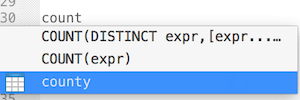MySql 中聚合函数增加条件表达式的方法
人气:0这篇文章主要介绍了MySql 中聚合函数增加条件表达式的方法,需要的朋友可以参考下
Mysql 与聚合函数在一起时候where条件和having条件的过滤时机
where 在聚合之前过滤
当一个查询包含了聚合函数及where条件,像这样的情况
select max(cid) from t where t.id<999
这时候会先进行过滤,然后再聚合。先过滤出ID《999的记录,再查找最大的cid返回。
having 在聚合之后过滤
having在分组的时候会使用,对分组结果进行过滤,通常里面包含聚合函数。
SELECT ip,MAX(id) FROM app GROUP BY ip HAVING MAX(id)>=5
先分组,再聚合,然后过滤聚合结果大于等于5的结果集
二者的区别:
where是先执行,然后再执行聚合函数。having是在聚合函数执行完之后再执行。
下面是补充
有个需求,某张表,有个状态字段(1:成功,2:失败,类似这样的),现要用日期分组统计不同状态下的数量
先写了个子查询
select aa.logDate,aa.totalLogs ,(select count(1) from dxp.dxp_handlermodel where aa.logDate=DATE_FORMAT( startTime, '%Y-%m-%d') and executeStatus=1) pendingLogs ,(select count(1) from dxp.dxp_handlermodel where aa.logDate=DATE_FORMAT( startTime, '%Y-%m-%d') and executeStatus=2) successLogs ,(select count(1) from dxp.dxp_handlermodel where aa.logDate=DATE_FORMAT( startTime, '%Y-%m-%d') and executeStatus=3) errorLogs ,(select count(1) from dxp.dxp_handlermodel where aa.logDate=DATE_FORMAT( startTime, '%Y-%m-%d') and executeStatus=4) callbackErrorLogs from ( select DATE_FORMAT( a.startTime, '%Y-%m-%d') logDate, count(1) totalLogs from dxp.dxp_handlermodel a group by DATE_FORMAT( a.startTime, '%Y-%m-%d') ) aa
执行相当慢,想到count中能不能加条件,找了一下,如下:
select DATE_FORMAT( startTime, '%Y-%m-%d') logDate, count(1) totalLogs, count(if(executeStatus=1,true,null)) pendingLogs, count(if(executeStatus=2,true,null)) successLogs, count(if(executeStatus=3,true,null)) errorLogs, count(if(executeStatus=4,true,null)) callbackErrorLogs from dxp.dxp_handlermodel group by DATE_FORMAT( startTime, '%Y-%m-%d')
简明易懂,且执行效率非常高

其它的聚合函数也可以用,如SUM等其他聚合函数
实战示例:
select count(if(create_date < '2017-01-01' and host_profile_id = '9294d2bf-f457-4fe5-9a36-e5f832310dc2',true,null)) from profile_visit_log -- 等同于 select count(if(create_date < '2017-01-01',true,null)) count from profile_visit_log where host_profile_id = '9294d2bf-f457-4fe5-9a36-e5f832310dc2'
好了这篇文章就介绍到这,希望大家以后多多支持。
加载全部内容